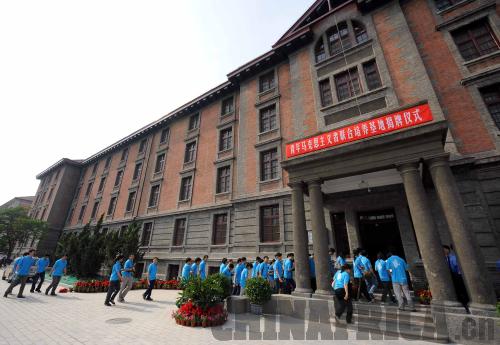|
 |
|
Beijing Memorial Hall of New Culture Movement |
North of the Forbidden City and east of Jingshan Park lies Beijing's Wusi Street or May Fourth Street. Its name originates with the May Fourth Movement, a pivotal anti-imperialist, cultural and political movement that began on May 4, 1919.
On that historic day, Peking University students departed from Hong Lou (Red Building), which was built in 1918 to house the university's library and literature department, and marched in the streets protesting. They were against what they perceived to be the unfair terms of the Treaty of Versailles, which gave then German-controlled Shandong Province to Japan instead of giving it back to China after the First World War.
Hong Lou also used to house the school's headquarters, classrooms and a printing factory. Located in the basement, the factory produced progressive magazines like The Renaissance (Xin Chao) and New Youth (Xin Qing Nian), both important publications in the development of the Communist Party of China (CPC).
The reading room in which Chairman Mao Zedong once worked as a librarian, and the classroom where Peking University students studied, are all well preserved.
At the beginning of 1918, Li Dazhao, one of the founders of the CPC, assumed the position of library curator of Peking University. Here he founded the Marxism Study Group. Marxist philosophy spread rapidly across the university campus and then to other regions. The building became the center for revolutionary activities in north China. It's also where the first Communist group in the north of the country was formed. As the birthplace of the May Fourth Movement (or New Culture Movement), Hong Lou exerted far-reaching influence on the Chinese revolution.
Today, the building still retaining its original facade, has become a memorial for the New Culture Movement. Photos, journals and videos on display detail the movement's history and relay stories of the CPC's founding.
Leaving the memorial hall and walking a bit further to the east, it's possible to find the May Fourth Movement Monument, which resembles part of a page from a book. On its front side, it depicts heroic leaders of the movement who later founded the CPC.
Along the street's east end is the National Art Museum of China, the biggest museum of its kind in the country. Covering an area of more than 18,000 square meters with 17 exhibition halls across five floors, the museum houses over 100,000 pieces in various collections. Most of these are modern and contemporary works, including master pieces by renowned contemporary Chinese artists, award-winning works from major art exhibitions, and various folk artworks.
Hutong Tips
How to get there
> By bus: Take bus101/ 103/ 109/ 111/112/619/810/ 812/ 814/ 819 to Shatan Station or take bus 104/108/111/420/803 to Meishuguan Station
What to see
> A must-see while visiting the National Art Museum is the exhibition "Glary Course · Age Scene - Art Works to Celebrate the 90th Anniversary of the Foundation of the CPC," which showcases 300 pieces of artwork, including traditional Chinese paintings, oil paintings, prints, sculptures and New Year paintings. The exhibit, found in Hall 1-9, runs from June 27 to July 18, 2011.
> Hours: Daily 9 a.m.-5 p.m. (No entry after 4 p.m.)
> Address: No.1 Wusi Street
> Website: www.namoc.org
What to eat
> Indulge in imperial-style cuisine at Cuiyuan "Ching and Han" Royal Dynasty Feast Restaurant, located in Cuihua hutong opposite of the Huaqiao Building. Located in the same hutong is Yuebin Restaurant, the city's first private restaurant, which opened in 1980. A little to the east of the museum is Longfusi Market, a haven for traditional Beijing snacks. |